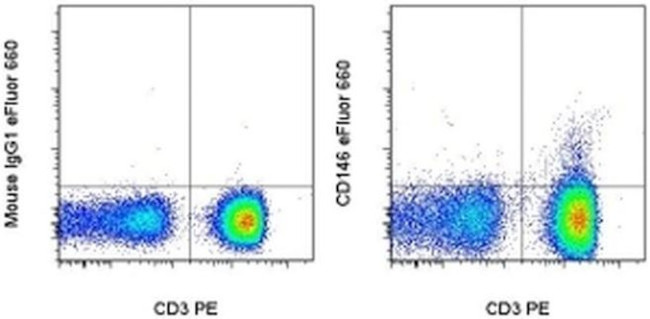Search Thermo Fisher Scientific
Invitrogen
CD146 Monoclonal Antibody (P1H12), eFluor™ 660, eBioscience™
FIGURE: 1 / 12
CD146 Antibody (50-1469-42) in Flow

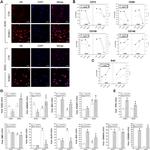

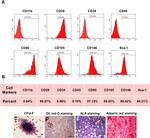
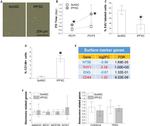
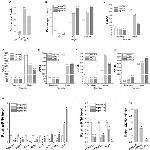

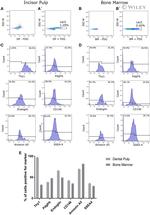
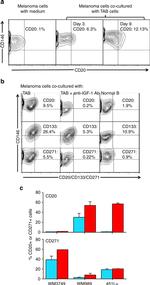


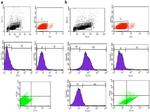
Product Details
50-1469-42
Species Reactivity
Published species
Host/Isotype
Recommended Isotype Control
Class
Type
Clone
Conjugate
Excitation/Emission Max
Form
Concentration
Purification
Storage buffer
Contains
Storage conditions
Shipping conditions
RRID
Product Specific Information
Description: The monoclonal antibody P1H12 recognizes CD146 also known as MUC18, s-endo, Endo-CAM and Mel-CAM, which is a member of the Ig superfamily of proteins. The expression of CD146 is found on endothelial cells, bone marrow fibroblasts and some tumors (especially melanoma). Recently mesenchymal stromal cells and endometrial stromal cells have also been shown to express CD146. The presence of CD146 on circulating blood cells have been confined to a subset of T cells rather than circulating endothelial cells, as expression of other endothelial markers (CD31 and CD51/61) is negative. Expression can be found on activated lymphocytes. The protein is heavily glycosylated with more than 50% of the mass from carbohydrates.
The antibody P1H12 has been reported to crossreact to mouse, rabbit, canine, but not rat.
Applications Reported: This P1H12 antibody has been reported for use in flow cytometric analysis.
Applications Tested: This P1H12 antibody has been pre-titrated and tested by flow cytometric analysis of normal human peripheral blood cells. This can be used at 5 µL (0.06 µg) per test. A test is defined as the amount (µg) of antibody that will stain a cell sample in a final volume of 100 µL. Cell number should be determined empirically but can range from 10^5 to 10^8 cells/test.
eFluor® 660 is a replacement for Alexa Fluor® 647. eFluor® 660 emits at 659 nm and is excited with the red laser (633 nm). Please make sure that your instrument is capable of detecting this fluorochome.
Excitation: 633-647 nm; Emission: 668 nm; Laser: Red Laser.
Filtration: 0.2 µm post-manufacturing filtered.
Target Information
CD146 (MCAM) is an integral membrane glycoprotein belonging to the immunoglobulin superfamily. CD146 is expressed at cell-cell junctions in all endothelial cells, and has also been observed in other normal and malignant cell types. In addition to its recognized role as a calcium-independent cell adhesion molecule, CD146 may also act as a signal transduction molecule in the recruitment of Fyn kinase, and in the subsequent tyrosine-phosphorylation of intracellular proteins involved in actin cytoskeleton assembly. CD146 plays a role in cell adhesion, and in cohesion of the endothelial monolayer at intercellular junctions in vascular tissue. CD146 expression may allow melanoma cells to interact with cellular elements of the vascular system, thereby enhancing hematogeneous tumor spread. Further, CD146 could be an adhesion molecule active in neural crest cells during embryonic development. CD146 acts also as surface receptor that triggers tyrosine phosphorylation of FYN and PTK2, and a transient increase in the intracellular calcium concentration.
For Research Use Only. Not for use in diagnostic procedures. Not for resale without express authorization.
How to use the Panel Builder
Watch the video to learn how to use the Invitrogen Flow Cytometry Panel Builder to build your next flow cytometry panel in 5 easy steps.
Bioinformatics
Protein Aliases: CD146; Cell surface glycoprotein MUC18; Cell surface glycoprotein P1H12; Gicerin; l-gicerin protein; melanoma adhesion molecule; Melanoma cell adhesion molecule; Melanoma-associated antigen A32; Melanoma-associated antigen MUC18; S-endo 1 endothelial-associated antigen
Gene Aliases: 1-gicerin; AV025631; CD146; CD149; MCAM; MUC18; s-endo; s-gicerin
UniProt ID: (Human) P43121, (Mouse) Q8R2Y2
Entrez Gene ID: (Rabbit) 100342848, (Human) 4162, (Dog) 489368, (Mouse) 84004

Performance Guarantee
If an Invitrogen™ antibody doesn't perform as described on our website or datasheet,we'll replace the product at no cost to you, or provide you with a credit for a future purchase.*
Learn more
We're here to help
Get expert recommendations for common problems or connect directly with an on staff expert for technical assistance related to applications, equipment and general product use.
Contact tech support
